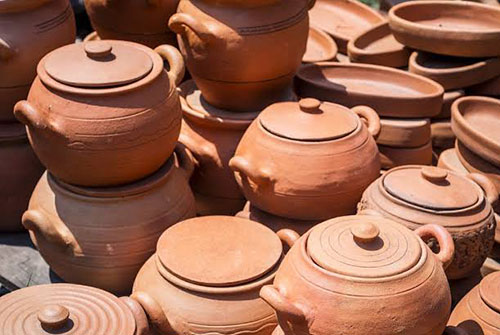
Terracotta is a brownish-red clay that has been baked and is used for making things such as flower pots, small statues, and tiles. The term Terracotta is also used to describe things that are brownish-red in colour.

The Ancient Greeks' Tanagra figurines were mass-produced mold-cast and fired terracotta figurines, often purely decorative in function. Indian sculpture made heavy use of terracotta from as early as the Indus Valley Civilization. Precolonial West African sculpture also made extensive use of terracotta. Chinese sculpture made great use of terracotta, with and without glazing and color, from a very early date. European medieval art made little use of terracotta sculpture, until the late 14th century when it became used in advanced International Gothic workshops in parts of Germany.

Clay minerals are composed essentially of silica, alumina or magnesia or both, and water, but iron substitutes for aluminum and magnesium in varying degrees, and appreciable quantities of potassium, sodium, and calcium are frequently present as well.
Terracotta is a brownish-red clay that has been baked and is used for making things such as flower pots, small statues, and tiles. The term Terracotta is also used to describe things that are brownish-red in colour.
Widely used in the art community to make sculptures, pots, statues, terracotta is a diverse material.

The temples of Bishnupur and Kalna are some of the finest examples of terracotta craft seen anywhere in the world. Other notable examples include the famous Terracotta Army of Chinese Emperor Qin Shi Huang and Imperial roof decoration in the Forbidden City.
It is light in weight, fire-resistant, frost-resistant and terracotta tiles are known to reduce noise pollution
Just a few drops of environmentally friendly soap to a bucket of water will be sufficient. Depending upon the level of grime, use either a soft cloth or a scrub brush to remove stains and dirt. Gently rinse the soap from the statue and either wipe dry with a soft cloth or allow it to air dry.